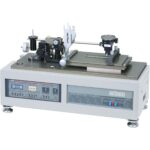Scratch Tester
Scratch resistance is calculated as the result of continuous loading. A scratch needle is loaded onto the test surface. The mobile base holding the test piece travels with the applied load. When the scratch or film peeling begins, the vertical load can be calculated as the distance to the failure point can be precisely measured.
Various needle diameters and materials can be used to properly test almost any surface. Scratch hardness an be measured by using a fixed load instead of the continuous load module. This system includes an analog output and PC data collection system.
SKU
H18L
Categories Friction, Wear and Surface Property Analyzers
$22,700.00
Additional
| Weight | 81 lbs |
|---|---|
| Dimensions | 31 × 20 × 30 in |






